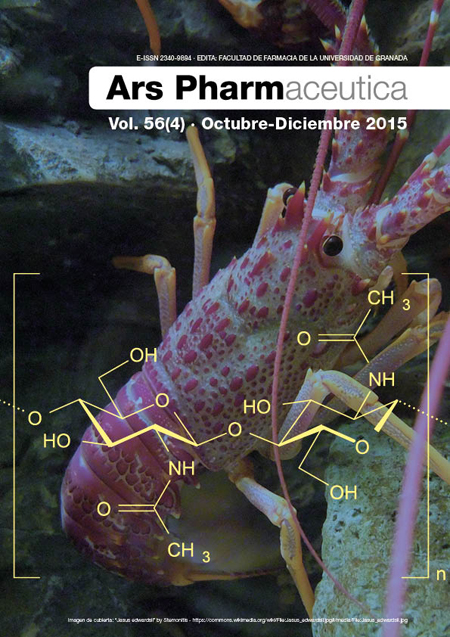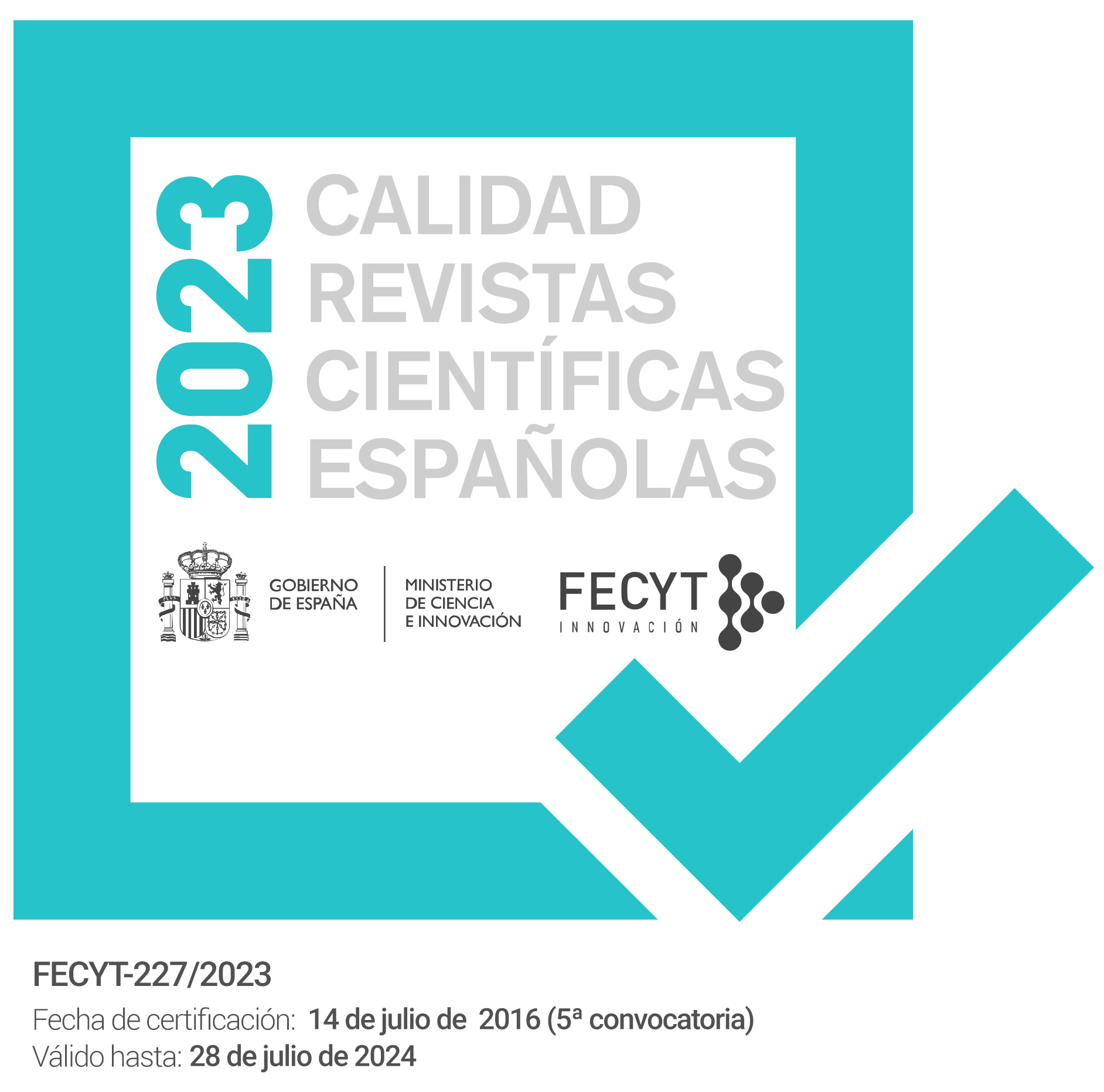Cardiovascular protection by flavonoids. Pharmacokinetic mystery
DOI:
https://doi.org/10.4321/s2340-98942015000400002Keywords:
Quercetin, Hypertension, Plasma MetabolitesAbstract
Objetives. Flavonoids have been proposed to exert beneficial effects in the prevention of cardiovascular diseases. In this review we try to clarify some fundamental questions regarding efficacy, mechanism of action and bioavailability of one of the most widely distributed flavonoids in the diet, quercetin.
Methods. The database of the National Library of Medicine, Washington, DC (MEDLINE PubMed) was used and all the studies in animals and humans available from inception of the database until November 2015 were collected.
Results. Quercetin exerts vasodilatory and antihypertensive effects in animal models of hypertension and hypertensive subjets. Quercetin is effective in all models of hypertension analyzed, independently of the origin of the hypertension, the status of renin–angiotensin system, oxidative stress, nitric oxide, and other factors. Paradoxically, despite exerting biologically demonstrable systemic effects, it is not found in plasma after oral administration and its circulating metabolites show weak activity in vitro. Quercetin is extensively metabolized into methylated and glucurono- and sulfo-conjugated metabolites, which are the plasma circulating forms; and glucurono-, but not sulfo-conjugates, can be hydrolyzed at the vascular level, yielding the parent aglycone which accumulates in tissues. Thus conjugation is a reversible process and, at least regarding the vasodilator and antihypertensive effects, the conjugation-deconjugation cycle appears to be an absolute requirement.
Conclusions. Glucuronidated derivatives transport quercetin and its methylated form, and deliver to the tissues the free aglycone, which is the final effector.
Downloads
References
Perez-Vizcaino F, Duarte J, Flavonols and cardiovascular disease.
Mol Aspects Med. 2010;31(6):478-494.
Martínez-Flórez S, González-Gallego J, Culebras JM, Tuñón MJ. Flavonoids: properties and anti-oxidizing action. Nutr Hosp. 2002;17(6):271-278.
Hertog MG, Feskens EJ, Hollman PC, Katan MB, Kromhout D.
Dietary antioxidant flavonoids and risk of coronary heart disease:
the Zutphen Elderly Study. Lancet. 1993;342(8878):1007-1011.
Manach C, Scalbert A, Morand C, Remesy C, Jiménez L. Polyphenols: food sources and bioavailability. Am J Clin Nutr. 2004;79(5):727-747.
Geleijnse JM, Launer LJ, Van der Kuip DA, Hofman A, Witteman
JC. Inverse association of tea and flavonoid intakes with incident myocardial infarction: the Rotterdam Study. Am J Clin Nutr. 2002;75(5):880-886.
Hertog MG, Bueno-de-Mesquita HB, Fehily AM, Sweetnam PM, Elwood PC, Kromhout D. Fruit and vegetable consumption and cancer mortality in the Caerphilly Study. Cancer Epidemiol Biomarkers Prev. 1996;5(9):673-677.
Huxley RR, Neil HA. The relation between dietary flavonol intake and coronary heart disease mortality: a meta-analysis of prospective cohort studies. Eur J Clin Nutr. 2003;57(8):904-908.
Miedema MD, Petrone A, Shikany JM, Greenland P, Lewis CE, Pletcher MJ, et al. The Association of Fruit and Vegetable Consumption During Early Adulthood With the Prevalence of Coronary Artery Calcium After 20 Years of Follow-Up: The CARDIA Study. Circulation. 2015. pii: CIRCULATIONAHA. 114.012562.
Duarte J, Perez-Vizcaino F, Utrilla P, Jimenez J, Tamargo J, Zarzuelo A. Vasodilatory effects of flavonoids in rat aortic smooth muscle. Structure-activity relationships. Gen Pharmacol. 1993;24(4):857-862.
Carlstrom J, Symons JD, Wu TC, Bruno RS, Litwin SE, Jalili T. A quercetin supplemented diet does not prevent cardiovascular
complications in spontaneously hypertensive rats. J Nutr. 2007;137(3):628-633.
Machha A, Mustafa MR. Chronic treatment with flavonoids prevents endothelial dysfunction in spontaneously hypertensive rat aorta. J Cardiovasc Pharmacol. 2005;46(1):36-40.
Romero M, Jimenez R, Sanchez M, Lopez-Sepulveda R, Zarzuelo MJ, O’Valle F, et al. Quercetin inhibits vascular superoxide production induced by endothelin-1: Role of NADPH oxidase, uncoupled eNOS and PKC. Atherosclerosis. 2009;202(1):58-67.
Sanchez M, Galisteo M, Vera R, Villar IC, Zarzuelo A, Tamargo
J, et al. Quercetin downregulates NADPH oxidase, increases eNOS activity and prevents endothelial dysfunction in spontaneously
hypertensive rats. J Hypertens. 2006;24(1),75-84.
Duarte J, Jimenez R, O’Valle F, Galisteo M, Perez-Palencia R, Vargas F, et al. Protective effects of the flavonoid quercetin in chronic nitric oxide deficient rats. J Hypertens. 2002;20(9):1843-1854.
Galisteo M, Garcia-Saura MF, Jimenez R, Villar IC, Wangensteen R, Zarzuelo A, et al. Effects of quercetin treatment on vascular function in deoxycorticosterone acetate-salt hypertensive rats. Comparative study with verapamil. Planta Med. 2004;70(4):334-341.
Garcia-Saura MF, Galisteo M, Villar IC, Bermejo A, Zarzuelo A, Vargas F, et al. Effects of chronic quercetin treatment in
experimental renovascular hypertension. Mol Cell Biochem.
;270(1-2):147-155.
Aoi W, Niisato N, Miyazaki H, Marunaka Y. Flavonoid-induced
reduction of ENaC expression in the kidney of Dahl saltsensitive
hypertensive rat. Biochem Biophys Res Commun. 2004;315(4):892-896.
Mackraj I, Govender T, Ramesar S. The antihypertensive effects of quercetin in a salt-sensitive model of hypertension. J Cardiovasc Pharmacol. 2008;51(3):239-245.
Jalili T, Carlstrom J, Kim S, Freeman D, Jin H, Wu TC, et al.
Quercetin-supplemented diets lower blood pressure and attenuate
cardiac hypertrophy in rats with aortic constriction. J Cardiovasc Pharmacol. 2006;47(4):531-541.
Rivera L, Moron R, Sanchez M, Zarzuelo A, Galisteo M. Quercetin ameliorates metabolic syndrome and improves the inflammatory status in obese Zucker rats. Obesity (Silver Spring). 2008;16(9):2081-2087.
Yamamoto Y, Oue E. Antihypertensive effect of quercetin in rats fed with a high-fat high-sucrose diet. Biosci Biotechnol Biochem. 2006;70(4):933-939.
Barker DJ. In utero programming of chronic disease. Clin Sci (Lond). 1998;95(2):115-28.
Buckley AJ, Keseru B, Briody J, Thompson M, Ozanne SE, Thompson CH. Altered body composition and metabolism in the male offspring of high fat-fed rats. Metabolism. 2005;54(4):500-507.
Liang C, Oest ME, Prater MR. Intrauterine exposure to high
saturated fat diet elevates risk of adult-onset chronic diseases in C57BL/6 mice. Birth Defects Res B Dev Reprod Toxicol. 2009;86(5):377-384.
Turnbull F. Effects of different blood-pressure-lowering regimens
on major cardiovascular events: results of prospectively-designed overviews of randomised trials. Lancet. 2003;362(9395):1527-1535.
Edwards RL, Lyon T, Litwin SE, Rabovsky A, Symons JD, Jalili T. Quercetin reduces blood pressure in hypertensive subjects. J Nutr. 2007;137(11):2405-2411.
Egert S, Boesch-Saadatmandi C, Wolffram S, Rimbach G, Muller
MJ. Serum lipid and blood pressure responses to quercetin vary in overweight patients by apolipoprotein E genotype. J Nutr. 2010;140(2):278-284.
Conquer JA, Maiani G, Azzini E, Raguzzini A, Holub BJ.
Supplementation with quercetin markedly increases plasma
quercetin concentration without effect on selected risk factors for heart disease in healthy subjects. J Nutr. 1998;128(3):593-597.
Perez A, Gonzalez-Manzano S, Jimenez R, Perez-Abud R, Haro JM, Osuna A, et al. The flavonoid quercetin induces acute vasodilator effects in healthy volunteers: correlation with beta-glucuronidase activity. Pharmacol Res. 2014;89:11-8.
Manach C, Williamson G, Morand C, Scalbert A, Remesy C.
Bioavailability and bioefficacy of polyphenols in humans. I. Review of 97 bioavailability studies. Am J Clin Nutr. 2005;81(1 Suppl):230S-242S.
Gugler R, Leschik M, Dengler HJ. Disposition of quercetin in man after single oral and intravenous doses. Eur J Clin Pharmacol. 1975;9(2-3):229-234.
Day AJ, Mellon F, Barron D, Sarrazin G, Morgan MR, Williamson G. Human metabolism of dietary flavonoids: identification of plasma metabolites of quercetin. Free Radic Res. 2001;35(6):941-952.
Williamson G, Manach C. Bioavailability and bioefficacy of
polyphenols in humans. II. Review of 93 intervention studies. Am J Clin Nutr. 2005;81(1 Suppl):243S-255S.
Kroon PA, Clifford MN, Crozier A, Day AJ, Donovan JL, Manach C, et al. How should we assess the effects of exposure to dietary polyphenols in vitro? Am J Clin Nutr. 2004;80(1):15-21.
Perez-Vizcaino F, Ibarra M, Cogolludo AL, Duarte J, Zaragoza-
Arnaez F, Moreno L, et al. Endothelium-independent vasodilator
effects of the flavonoid quercetin and its methylated metabolites in rat conductance and resistance arteries. J Pharmacol Exp Ther. 2002;302(1):66-72.
Lodi F, Jimenez R, Moreno L, Kroon PA, Needs PW, Hughes DA, et al. Glucuronidated and sulfated metabolites of the flavonoid quercetin prevent endothelial dysfunction but lack direct vasorelaxant effects in rat aorta. Atherosclerosis. 2009;204(1):34-39.
Bieger J, Cermak R, Blank R, de Boer VC, Hollman PC, Kamphues
J, et al. Tissue distribution of quercetin in pigs after long-term dietary supplementation. J Nutr. 2008;138(8):1417-1420.
O’Leary KA, Day AJ, Needs PW, Sly WS, O’Brien NM, Williamson
G, Flavonoid glucuronides are substrates for human liver beta-glucuronidase. FEBS Lett. 2001;503(1):103-106.
Shimoi K, Saka N, Nozawa R, Sato M, Amano I, Nakayama T, et al. Deglucuronidation of a flavonoid, luteolin monoglucuronide, during inflammation. Drug Metab Dispos. 2001;29(12):1521-1524.
Lee-Hilz YY, Stolaki M, van Berkel WJ, Aarts JM, Rietjens IM.
Activation of EpRE-mediated gene transcription by quercetin
glucuronides depends on their deconjugation. Food Chem Toxicol. 2008;46(6):2128-2134.
Kawai Y, Nishikawa T, Shiba Y, Saito S, Murota K, Shibata N, et al. Macrophage as a target of quercetin glucuronides in human atherosclerotic arteries: implication in the anti-atherosclerotic
mechanism of dietary flavonoids. J Biol Chem. 2008;283(14):9424-9434.
Terao J, Murota K, Kawai Y, Conjugated quercetin glucuronides
as bioactive metabolites and precursors of aglycone in vivo. Food Funct. 2011;2(1):11-17.
Menendez C, Dueñas M, Galindo P, Gonzalez-Manzano S, Jimenez R, Moreno L, et al. Vascular deconjugation of quercetin glucuronide: The flavonoid paradox revealed? Mol Nutr Food Res. 2011;55(12):1780-1790.
Jimenez R, Lopez-Sepulveda R, Romero M, Toral M, Cogolludo A, Perez-Vizcaino F, et al. Quercetin and its metabolites inhibit the membrane NADPH oxidase activity in vascular smooth muscle cells from normotensive and spontaneously hypertensive rats. Food Funct. 2015;6(2):409-414.
Galindo P, Rodriguez-Gómez I, González-Manzano S, Dueñas M, Jiménez R, Menéndez C, et al. Glucuronidated quercetin lowers blood pressure in spontaneously hypertensive rats via deconjugation. PLoS One. 2012;7(3):e32673.
van Duynhoven J, Vaughan EE, Jacobs DM, Kemperman RA, van Velzen EJ, Gross G, et al. Metabolic fate of polyphenols in the human superorganism. Proc Natl Acad Sci U S A. 2011;108(Suppl 1):4531-4538.
Boesch-Saadatmandi C, Niering J, Minihane AM, Wiswedel I,
Gardeman A, Wolffram S. Impact of apolipoprotein E genotype
and dietary quercetin on paraoxonase 1 status in apoE3 and apoE4 transgenic mice. Atherosclerosis. 2010;211(1):110-113.
Bartholome R, Haenen G, Hollman CH, Bast A, Dagnelie PC, Roos D, et al. Deconjugation kinetics of glucuronidated phase II flavonoid metabolites by beta-glucuronidase from neutrophils. Drug Metab Pharmacokinet. 2010;25(4):379-387.
Downloads
Published
How to Cite
Issue
Section
License
The articles, which are published in this journal, are subject to the following terms in relation to the rights of patrimonial or exploitation:
- The authors will keep their copyright and guarantee to the journal the right of first publication of their work, which will be distributed with a Creative Commons BY-NC-SA 4.0 license that allows third parties to reuse the work whenever its author, quote the original source and do not make commercial use of it.
b. The authors may adopt other non-exclusive licensing agreements for the distribution of the published version of the work (e.g., deposit it in an institutional telematic file or publish it in a monographic volume) provided that the original source of its publication is indicated.
c. Authors are allowed and advised to disseminate their work through the Internet (e.g. in institutional repositories or on their website) before and during the submission process, which can produce interesting exchanges and increase citations of the published work. (See The effect of open access).























